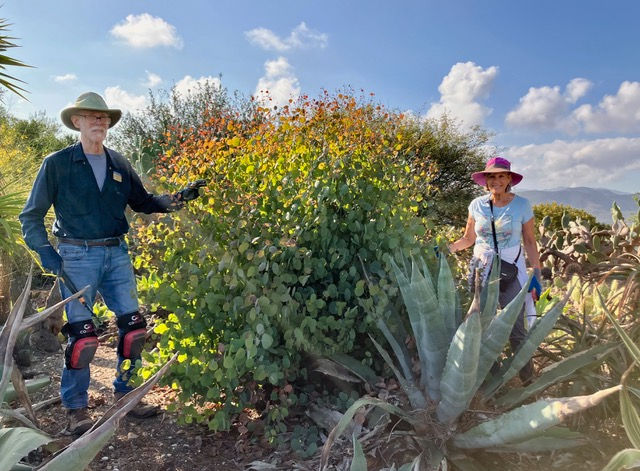Garden Activities: September 16, 2025
- Conejo Valley Botanic Garden

- Sep 18
- 2 min read
Tuesday was another hot one, so we took it fairly easy. Braving the warm humid (at least it felt humid) weather were: Isis Gabor, Kelly Colindres, Bill Dobner, Dale Harshberger, Daryl Stutley, Nancy Taylor Walker, Marna Wensil, Ann Wright, and myself. Bill did his catching up with the compost, and watering the service area and shade house plants as needed. I was happy to note that the ground around the sycamore was damp so someone, probably Jim Cyr, must be giving it special attention.
We spent our work time on the Trail of Trees cutting out sprouts, deadheading penstemon, and identifying plants. The first thing we came upon was a stand of CA buckwheat. It is on the right just at the entrance to the TofT. It is a perfect example of the hybridization of Eriogonum species in nature, making a definitive identification sometimes difficult. In that one section, the plants have different leaf types, variable flower clusters, and slightly different flower maturation timing (some were still white while other plants were a rich copper color). Irrigation or lack thereof, can also create variation between plants.

Formerly, in the same area were specimens of E. giganteum (St. Catheriine’s lace) which looks different from CA buckwheat but which could have crossed with it to create some of the current variations. Below is an image of the one I showed in a previous update from my garden which has now turned a beautiful copper color.




After removing the sprouts from around the laurel sumac and jacaranda tree, we headed back to survey the Mediterranean Garden. On the way, we spotted a willowy “weed” that turned out to be an Epilobium brachycarpum (it has several common names many of which are variations of willowherb). We tried to take a photo, but the breeze was too strong so the following is an image in the public domain from Wikipedia and Calscape.

As you can see the flower is tiny. It has four deeply split petals. In our specimens, the pairs of petal parts are arranged in a distinct cross which looks more like 4 pairs of petals than is illustrated above. This plant is in the same genus as CA fuchsia, and it has seeds that look like milkweed seeds with long hairs that help the seeds travel on the wind. It is native to most of southern Canada, the western US and as far south as central Mexico,
Finally, as we were returning to the service area, board president Monica Barton walked up to meet Isis and Kelly, and to show us an article from The Rancher, a publication of the Lynn Ranch neighborhood, which contains an article about the CVBG for which board member Jim Allyn was interviewed.

Enjoy the garden (and hopefully the rain later this week)! KMM




Comments